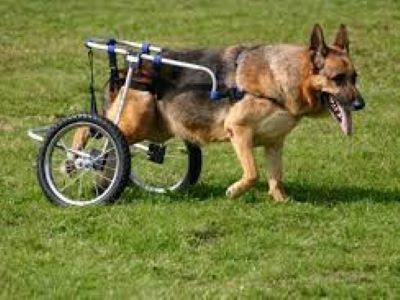Have you ever witnessed a dog that appeared to struggle with balance, coordination, or walking? If so, you could have seen an instance of ataxia.
Ataxia is a term used to indicate a lack of normal nervous system function, which affects balance and coordination.

Depending on the underlying reason, it may have an impact on the head, limbs, or trunk of the body. Many forms and causes of ataxia exist, some of which are more dangerous than others.
In this article, We’ll define ataxia, go through how to spot its warning signs and symptoms, and discuss some potential therapies. By the time you finish reading this article, you will know more about “what is ataxia in dogs?” and how to treat your pet if they ever have it.
Contents
What Is Ataxia?
The word ataxia means incoordination within the nervous system. The abnormal movement can occur in the legs, the head, the torso, or all three. There are several different forms of ataxia, depending on where in the nervous system the abnormality occurs.

Types of Ataxia in Dogs
Ataxia is a general term that describes a loss of coordination and balance in dogs. It can have various causes and symptoms, depending on which part of the nervous system is affected.
There are three main types of ataxia in dogs: vestibular, cerebellar, and proprioceptive. In this section, we will explain each type of ataxia in more detail and how to recognize them.
1). Vestibular Ataxia in Dogs: Vestibular ataxia is a type of ataxia that affects the inner ear or the brainstem, which are responsible for maintaining balance and orientation.
Dogs with vestibular ataxia may show signs such as head tilt, abnormal eye movements (nystagmus), and circling or leaning toward one side. They may also have difficulty standing or walking, and may vomit or drool due to nausea.
There are many possible causes of vestibular ataxia in dogs, such as idiopathic vestibular disease (also known as old dog vestibular disease), ear infections, tumors, trauma, hypothyroidism, or certain medications.
Some of these causes are more common or serious than others, and some may affect the central vestibular system (brainstem) or the peripheral vestibular system (inner ear) differently.

a). Diagnoses of Vestibular Ataxia in Dogs: Vestibular ataxia in dogs is a condition that affects the balance and orientation of the dog.
It can be caused by various factors, such as ear infections, head injuries, or brain diseases. A veterinarian can diagnose it by examining the dog and performing tests.
b). Treatment of Vestibular Ataxia in Dogs: The treatment and prognosis depend on the cause and severity of the condition. Some dogs may improve with supportive care or medications, while others may need surgery or chemotherapy.
Some dogs may recover completely or partially, while others may have lasting effects or complications.
2). Cerebellar Ataxia in Dogs: Cerebellar ataxia is a type of ataxia that affects the cerebellum, which is the part of the brain that controls movement and coordination.

Dogs with cerebellar ataxia may show signs such as exaggerated gait, head tremors, and difficulty with fine movements. They may also have trouble judging distances or speeds, and may overshoot or undershoot their targets.
The causes of cerebellar ataxia in dogs can be congenital (present at birth) or acquired (developed later in life). Congenital causes include genetic defects, infections during pregnancy, or trauma during delivery.
Some breeds are more prone to congenital cerebellar ataxia, such as wire-haired fox terriers, Irish setters, Samoyeds, chow chows, and rough-coated collies. Acquired causes include infections, toxins, tumors, degeneration, or trauma that damage the cerebellum.
a). Diagnoses of Cerebellar Ataxia in Dogs: Cerebellar ataxia in dogs is a condition that affects the movement and coordination of the dog.
It can be caused by various factors, such as genetic defects, infections, toxins, or tumors. A veterinarian can diagnose it by examining the dog and performing tests.
b). Treatment of Cerebellar Ataxia in Dogs: The treatment and prognosis depend on the cause and severity of the condition. Some dogs may improve with medications or surgery, while others may deteriorate or die.
3). Proprioceptive Ataxia in Dogs: Proprioceptive ataxia is a type of ataxia that affects the spinal cord, which transmits sensory and motor signals between the brain and the body.
Dogs with proprioceptive ataxia may show signs such as weakness, stumbling, and dragging of toes. They may also have difficulty standing or walking, and may sway or fall over.
Dogs may develop proprioceptive ataxia for a variety of reasons, including spinal cord compression brought on by tumors, infections, inflammation, cysts, or blood clots.
Congenital (existing at birth) or acquired conditions may cause some of these factors (developed later in life). Breeds including German shepherds, Boxers, Rottweilers, and Doberman Pinschers are more likely to have spinal cord disorders.

a). Diagnoses of Proprioceptive Ataxia in Dogs: Proprioceptive ataxia in dogs is a condition that affects the sensory and motor function of the dog.
It can be caused by various factors, such as tumors, infections, inflammation, or blood clots. A veterinarian can diagnose it by examining the dog and performing tests.
b). Treatment of Proprioceptive Ataxia in Dogs: The treatment and prognosis depend on the cause and severity of the condition. Some dogs may improve with medications or surgery, while others may worsen or become paralyzed.
FAQs
Can a dog recover from ataxia?
The recovery of a dog from ataxia depends on the cause and severity of the condition. Some dogs may not recovered lost balance and coordination of their legs, but most of the dogs can live normal life.
What are the early signs of ataxia in dogs?
Ataxic dogs may fall, struggle to move ahead, round their feet, or tilt their heads. Your dog’s eyes might be seen to dart up and down or side to side. Your dog may feel uneasy, nauseous, and even vomit as a result of vestibular ataxia.
What do you do if your dog has ataxia?
It’s extremely important to schedule an appointment with your veterinarian right away if you think your dog may be experiencing ataxia. To ascertain the underlying cause of ataxia, your veterinarian will do a physical exam and could suggest further diagnostics like imaging (x-rays, MRI scans).
Can ataxia be cured?
Ataxia does not have a particular therapy. In certain circumstances, fixing the underlying issue may help the ataxia get better. Some instances, such ataxia brought on by chickenpox or other viral diseases, are more likely to go away on their own.
Conclusion
Dogs suffering from the neurological disorder ataxia have loss of balance and coordination. Depending on the area of the brain or spinal cord is impacted, it can have a variety of causes and kinds.
- The health and quality of life of your dog may suffer significantly as a result of ataxia, so it’s crucial to get them checked out by a vet as soon as you see any indications of weakness, incoordination, or strange movements.
- Your veterinarian will identify the underlying cause of the ataxia and offer the best course of action and prognosis.
- While some ataxia instances may be curable or managed, others could worsen or be deadly.
Hopefully now you have better understanding of what is ataxia in dogs, how many types of ataxia in dogs are there and what is the diagnosis and treatment of each types of atoxia in dogs.
Ataxia may affect your dog’s balance, but it doesn’t have to affect your bond. With love and care, you can help your dog overcome the challenges of this condition and enjoy every moment together.

Julia is a Board Certified Veterinary Nutritionist, practicing veterinarian in a non-profit animal hospital and feline sanctuary located in Rochester, NY. She is also a full-time veterinary advisor at DogLikesBest. She focuses on writing healthcare-related topics including dog foods, treats, veterinary diets, food for specific healthcare features, etc. Moreover, any article on DogNeedsBest that has to concern feline health in any way, goes under her scrutiny before being published.

